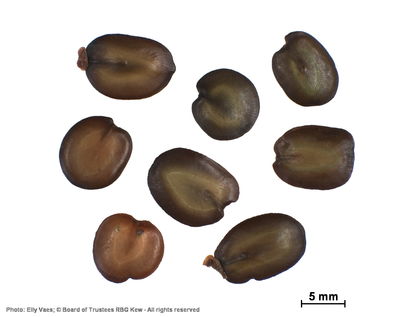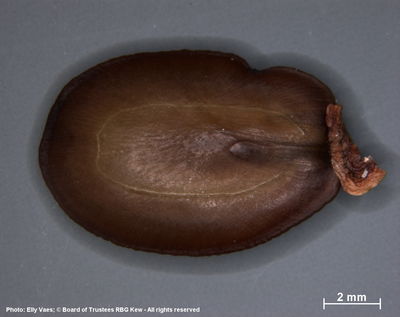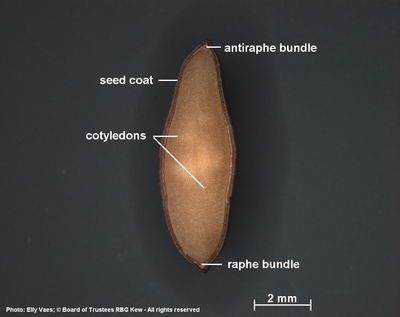Geography and distribution
Found in tropical and southern humid Africa, flat-crown albizia also occurs in eastern Madagascar.
It grows in a wide range of soil types, most often occurring on sandy soils and usually between 250-600 m, though it can occur up to 1,700 m above sea level.
It usually grows in evergreen forest, deciduous woodland, wooded grassland, secondary vegetation, remnant miombo woodland among cultivated fields and along the banks of streams.
Description
Overview: A tree up to 35 m tall, with a slightly buttressed trunk up to 95 cm in diameter. The bark is grey to yellowish-brown and fairly smooth or sometimes roughish (likened by some to crocodile skin).
Leaves: Up to 20 cm long, resembling fronds of the fern genus Adianthum , from which the species takes its name ( adianthifolia ). The stipules (leaf-like appendages) are relatively large, 7.0 mm long and 2.5 mm wide, lanceolate and readily detach from the plant. The petioles (leaf stalks) are densely hairy and have a gland (extra-floral nectary) near the base.
Flowers: Reddish or greenish white, bisexual and almost sessile (lacking a flower stalk), aggregated into stalked heads. The petals are partly fused into a 5-9 mm long tube, which is hairy on the outside. The red to pink or greenish stamens (male parts) are numerous, 3-4 cm long (and thus protrude a long way from the tube formed by the petals), and are united into a tube for most of their length, although the tips are free and presented like an open fan. The long staminal tubes suggest that it is pollinated by butterflies or moths. At least two butterflies - the blue spotted charaxes ( Charaxes cithaeron ) and the satyx charaxes ( C. ethalion ) - have been reported to breed on it in the Natal province of South Africa.
Fruits: A flat pod 9.0-19.0 × 2.0-3.5 cm, covered in dense but fine hairs, with a stipe (stalk) about 5 mm long. The fruit is pale brown when ripe and opens along the margin exposing 7-10 seeds.
Similar species
Albizia adianthifolia is frequently confused with Albizia gummifera , which differs in its almost hairless leaflets and hairless pods. However, almost hairless plants of Albizia adianthifolia have also been recorded, and more research is needed to confirm the separation of the two species. Possible hybrids have been recorded from Malawi and Mozambique.
Threats and conservation
Albizia adianthifolia has been recorded as common in its natural habitat, and although it is used in many different ways, it is not currently threatened by over-exploitation. It is sometimes even considered an aggressive colonizer. There are no known conservation measures specifically for flat-crown albizia, but it occurs in many protected areas. Samples of seeds are stored in Kew's Millennium Seed Bank as an ex situ conservation measure.
Conservation assessments carried out by Kew
Albizia adianthifolia is being monitored as part of the IUCN Sampled Red List Index for Plants project, which aims to produce conservation assessments for a representative sample of the world's plant species. This information will then be used to monitor trends in extinction risk and help focus conservation efforts where they are needed most.
Uses
Albizia adianthifolia is often used for firewood and making charcoal. It is also planted as a shade tree for crops such as cocoa and tea and for soil improvement and conservation, as it produces a deep and expansive rooting system and protects crops from the sun. The leaves are boiled to make a drink, and the bark is cooked with food in Madagascar. Its sweet-smelling gum or resin is used in cosmetics in some African countries.
The roots, bark and young shoots are widely used in traditional medicine. The bark is poisonous but is used medicinally by the Zulu of South Africa who also sometimes make a love charm from the plant. They also prepare an infusion (hot or cold) from the bark and roots to treat skin diseases such as scabies. A cold extract from the roots alone is applied to inflamed eyes. In Mozambique, the bark is used in a remedy for bronchitis. Sap from the fresh bark is used in Congo (Brazzaville) to kill filaria in the eye mucosa and is also administered for conjunctivitis, the latter apparently being a painful treatment.
There are at least 70 local names for the whole plant or fruits, seeds and products made from it.
Millennium Seed Bank: Seed storage
The Millennium Seed Bank Partnership aims to save plant life worldwide, focusing on plants under threat and those of most use in the future. Seeds are dried, packaged and stored at a sub-zero temperature in our seed bank vault.
Two collections of Albizia adianthifolia seeds are held in Kew's Millennium Seed Bank based at Wakehurst in West Sussex.
Cultivation
Seeds should be collected from pods that are still attached to the tree to reduce damage by bruchids (seed boring beetles) and should be dried immediately after collection. Seeds can be stored for up to 3 months if ash is added to reduce insect damage. Experiments in Ghana have shown that Albizia adianthifolia can be successfully propagated vegetatively by root cuttings. Seedlings require strong light in order to become established in the wild.
This species at Kew
Dried and alcohol-preserved specimens of Albizia adianthifolia are held in Kew's Herbarium where they are available to researchers by appointment. The details of some of these, including some images, can be seen online in Kew's Herbarium Catalogue.
Specimens of bark and wood from flat-crown albizia are held in Kew's Economic Botany Collection, where they are available to researchers, by appointment.









